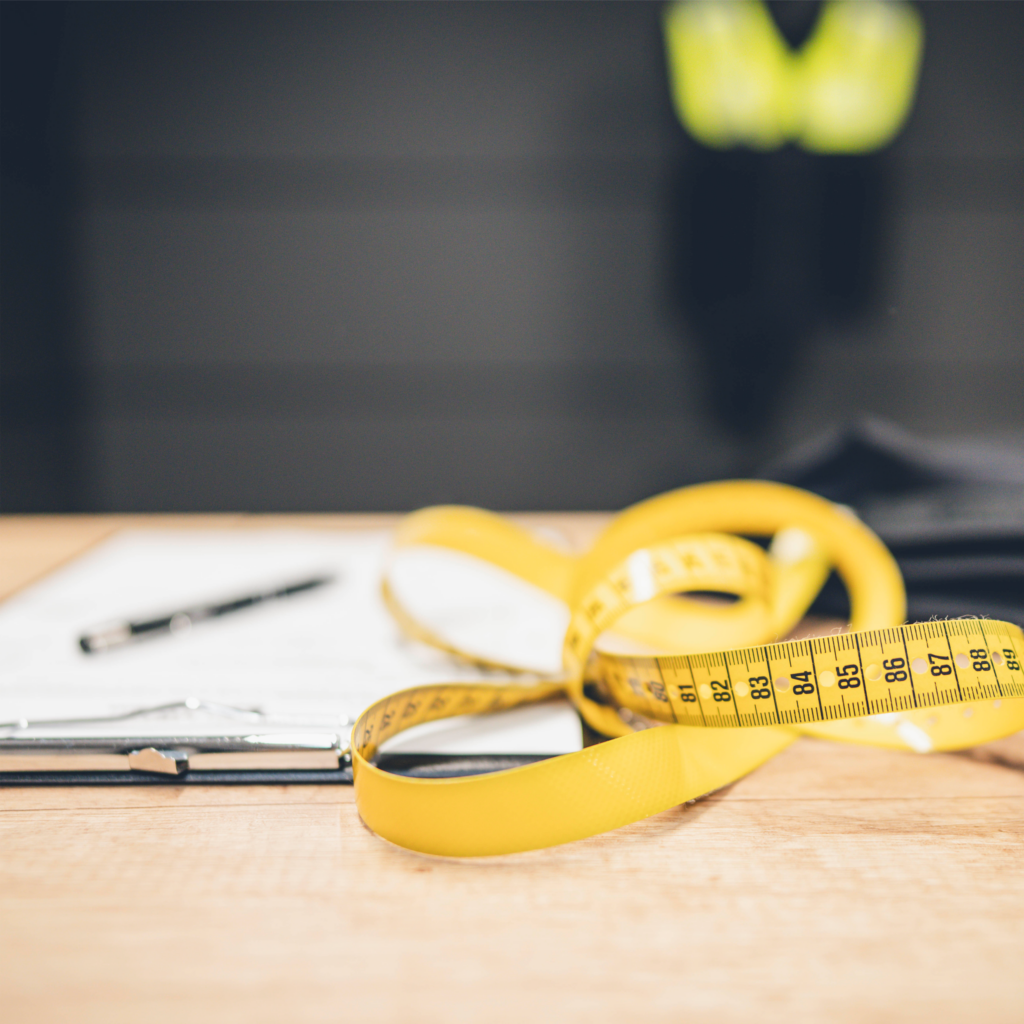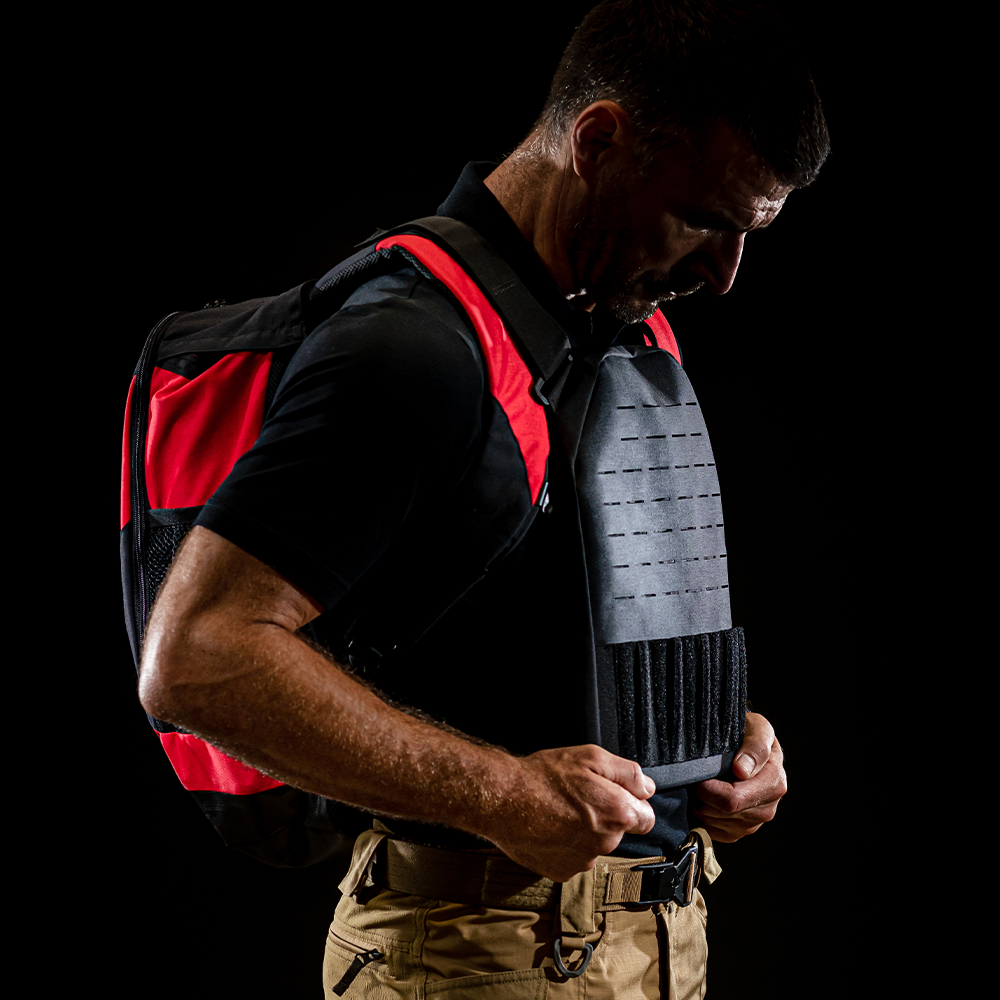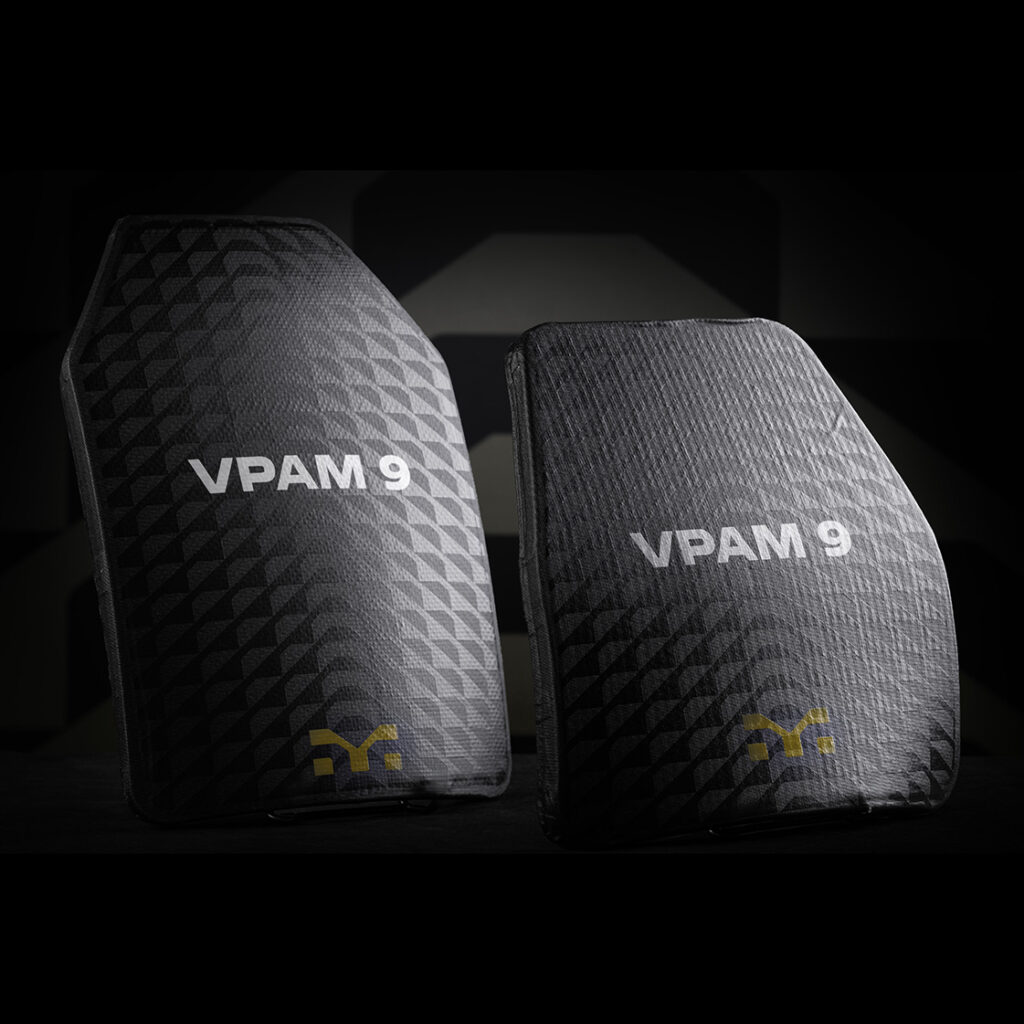
Riot gear essentials: Responding to global protests and civil unrest
Major events such as the 2024 Olympic Games in Paris have highlighted the need for an increased security presence. The French government emphasised the persistent threat of terrorism and took far-reaching precautions that legitimised the deployment of 45,000 police officers. Additionally, more than 2,000 special forces were mobilized from abroad to secure the Games and support French forces in critical areas. A notable side effect has been a significant reduction in the crime rate in Paris since the increase in police presence.
Considering the global protests and civil unrest often associated with such events, the importance of riot gear — equipment designed to control crowds and riots — is becoming increasingly apparent. Especially when seemingly peaceful events suddenly turn violent, the importance of riot gear becomes apparent.
As protests around the world grow more frequent and intense, many countries are investing more in equipping police forces to ensure the safety of officers while protecting the civilian population. This includes not only protective equipment such as helmets and waistcoats, but also non-lethal weapons and communication tools that enable effective control and de-escalation of conflict situations. In this blog post, we will examine the essential components of riot gear.
The importance of custom-fit riot gear
Riot gear refers to the protective equipment used by police, law enforcement, and correctional authorities. This equipment is used for all types of riots such as demonstrations, violent confrontations, major events such as sporting events or political events with a particularly high risk potential. With high-quality protective equipment that can be used from head to toe, everything is undertaken to ensure that the officers can go home unharmed at the end of the operation.
Protecting operational forces is a top priority for many local authorities. People come in all shapes and sizes, and so does protective equipment. The challenge is to provide a body protection system that fits everyone correctly. Equipment that does not fit properly cannot protect as it should. It can cause protective plates to shift and slip, potentially leading to injuries. Additionally, poorly fitting gear restricts the officer’s mobility. A body armour system that is too tight prevents the officer from acting quickly to control crowds during riots, demonstrations and other stressful situations. Therefore, riot gear should minimize discomfort and maintain mobility, even when worn for extended periods. The mobility of the arms should always be guaranteed when wearing the complete protective equipment.
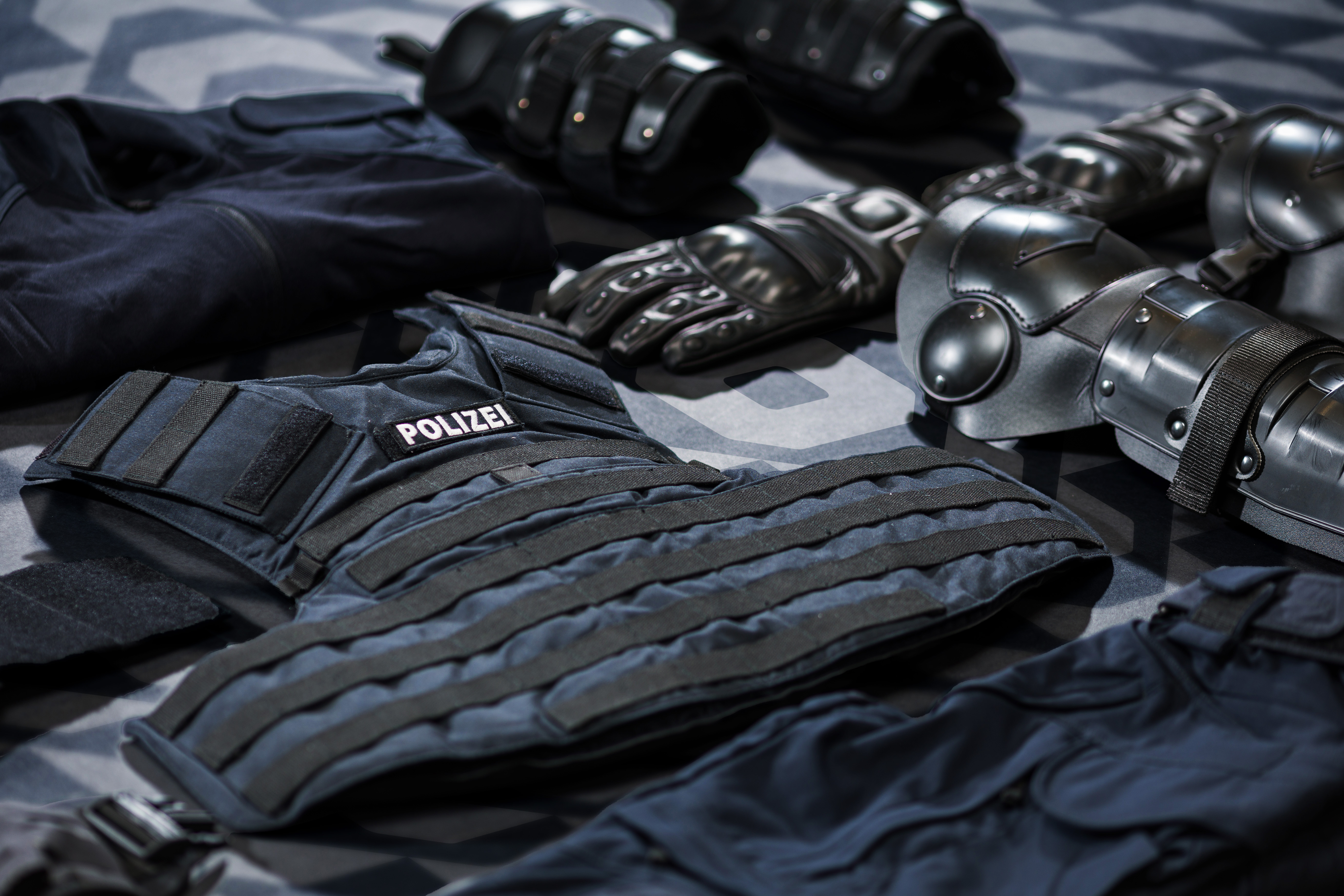
What components does riot gear consist of?
Depending on the level of risk, riot control equipment can be used in various ways and may appear quite different to outsiders. The body armor protectors are enclosed in a range of protective vest covers, and impact protection equipment can also be worn under uniform clothing. There are numerous combinations for slash, impact, and stab protection, making these systems highly diverse in their design features.
The basic equipment includes a bulletproof vest system with large hook-and-loop or fleece fasteners, leg protectors, and helmets. These components cover and protect most of the body.
Depending on the situation and potential threats, this basic setup can be upgraded with impact-absorbing upper arm, elbow, and forearm protectors, which are attached to the shoulder section of the outer vest shell using hook-and-loop or snap fasteners. Double elbow protectors offer even more freedom of movement. All components can be removed and replaced individually. The sizes of the waistcoat and arm protectors are always customised to the size of the emergency services in order to guarantee an optimum fit and good mobility.
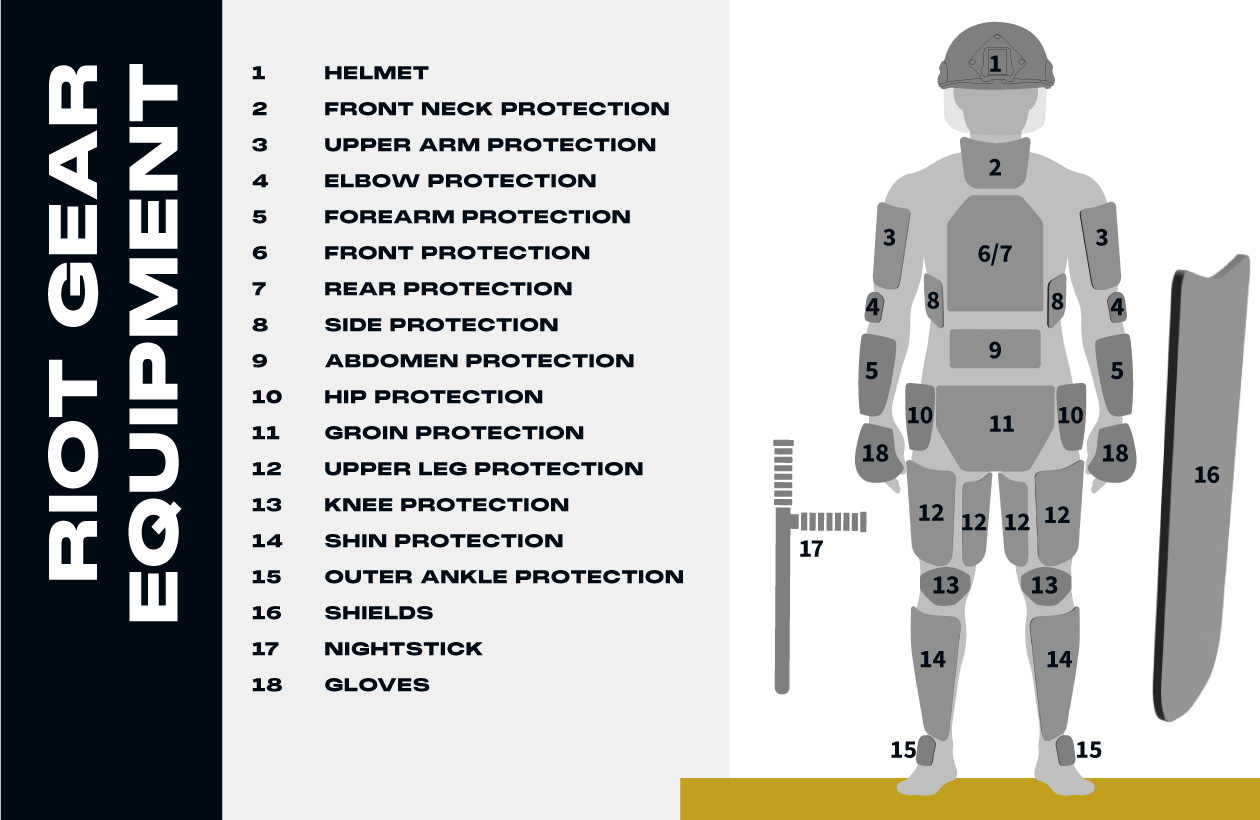
Protectors for upper body impact protection
The versatility of riot control gear is particularly evident when focusing on upper body protection. The body protectors feature a wide variety of components and designs:
- different sized openings for the head,
- different shoulder sizes with additional shoulder padding,
- reinforced collarbone protection,
- various chest and back protectors, variable in length, with ventilation slits (against heat build-up) or without,
- various side protectors,
- different forearm sizes,
- single or double elbow protectors,
- various hook-on extension elements,
- short version
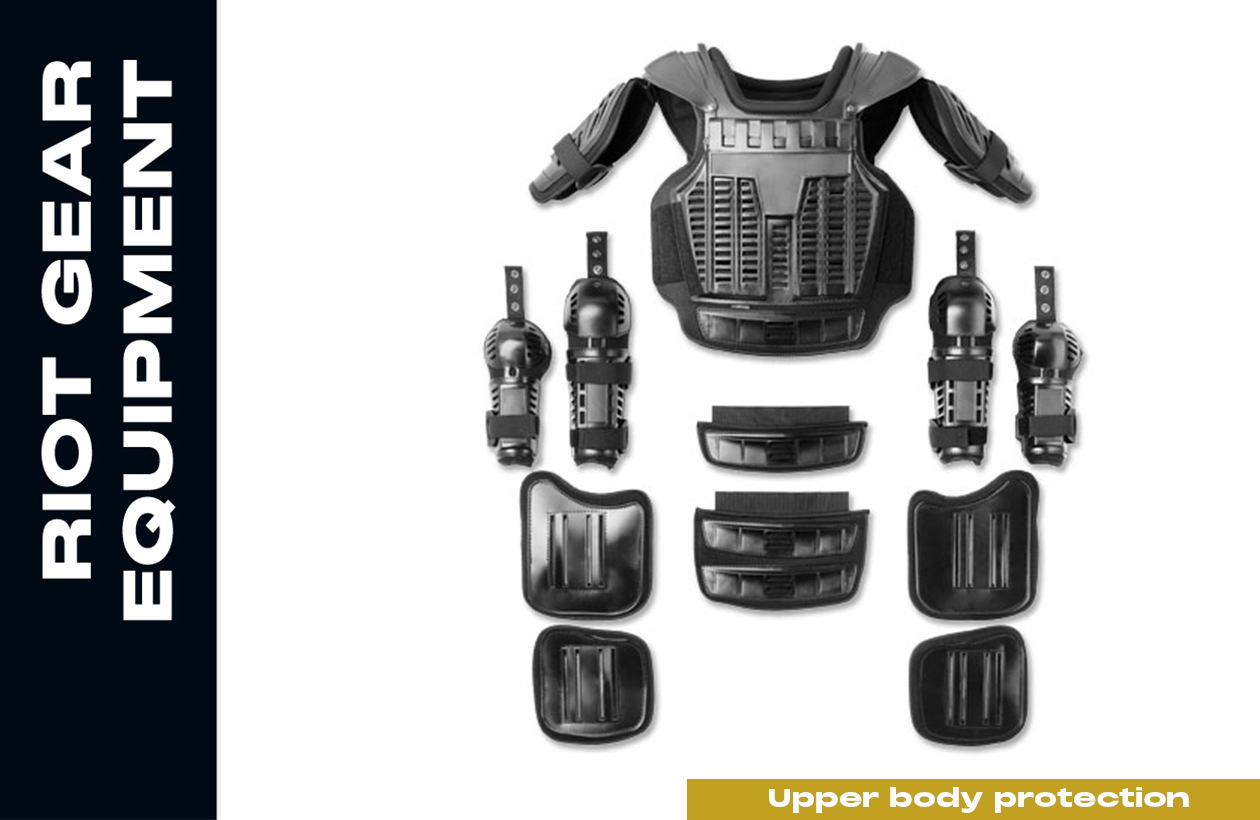
Protective vest covers for body armour protectors
The design of protective vest outer shells is as varied as the body protectors themselves. They can be either open at the front, allowing the chest protectors to be split in the center, or fully closed. Large hook-and-loop fasteners provide customizable adjustments for the vests, which are typically available in standard sizes ranging from XS to XXL.
Impact-absorbing upper and lower arm protectors are attached to the shoulder section of the outer shell. Alternatively, overlays can be used instead of protective vest covers, and the arm protectors can also be attached directly to the outer shell. All body protection models with protective vest outer shells can be further upgraded with ballistic inserts.
Leg protectors
Anatomically shaped protectors are necessary for police, emergency and special forces in order to optimally protect the knee, meniscus, shin, instep and ankle during use. These should not adversely affect the wearer’s mobility and agility. In addition to single protector shells for knees, there are also double shells that offer even more freedom of mobility and impact protection for the knee and patellar tendon. Manufacturers work with generous inner padding to make them as comfortable as possible to wear. There is a wider range of sizes for leg protectors. Here, manufacturers produce sizes from XS to XXXL.
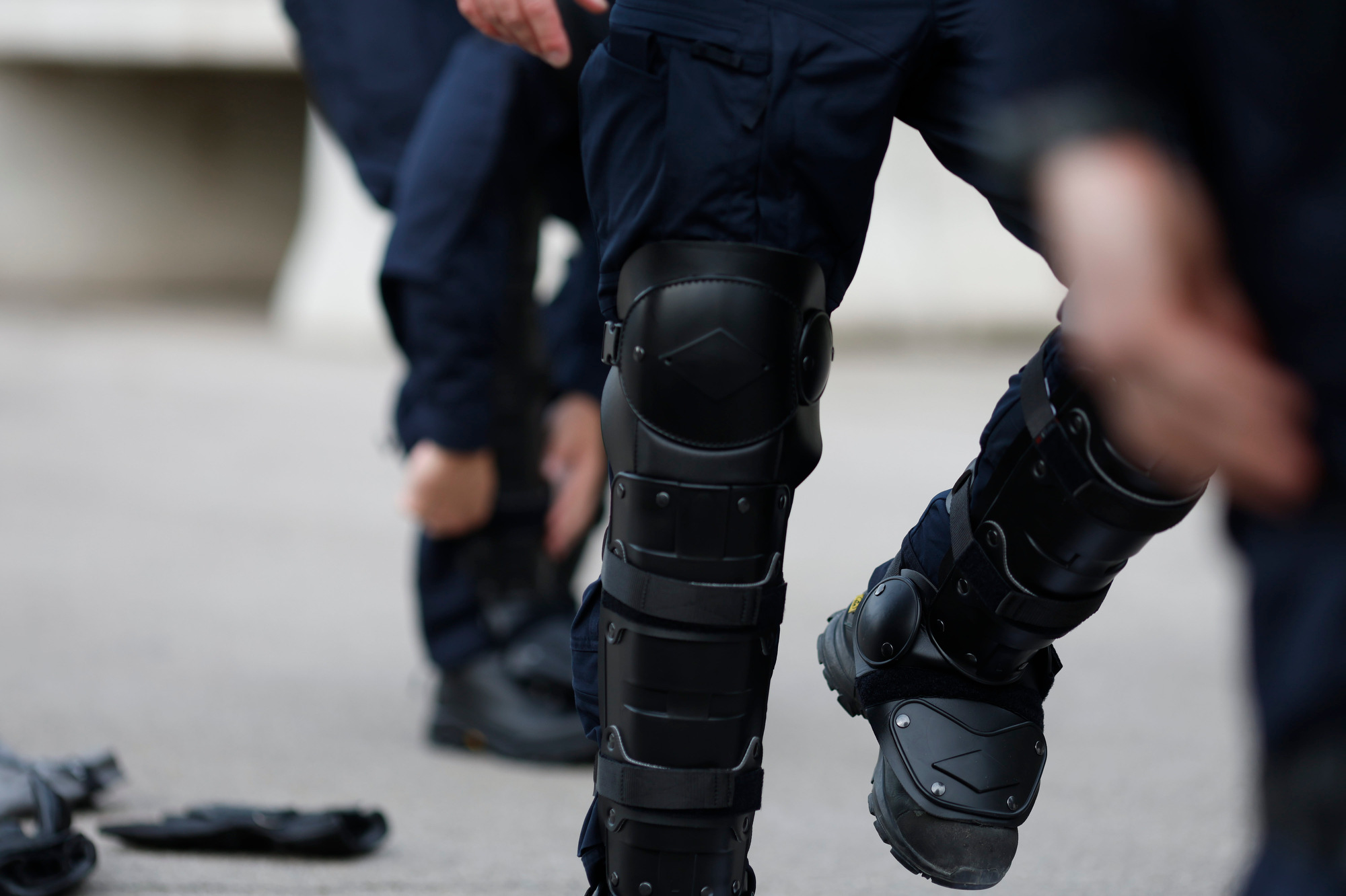
Application example: Mounted police
In the event of civil unrest, high-quality protective equipment is not only crucial for on-foot police officers, but also serves a central role in the deployment of mounted police. Specially developed riot gear systems ensure that police officers in the saddle are optimally protected. Knee and shin protectors are designed to protect the outer ankle with oval protector shells and lateral meniscus protection, without compromising the rider’s mobility and feel for their horse. This ensures both maximum protection and the necessary flexibility for effective use on horseback.
Shields
Riot Gear components include protective shields, designed to offer increased defense against stabbing, slashing, and throwing objects, as well as to stop and push away disruptive forces. The wearer’s torso must be covered by the shield. In addition, shields can be equipped with a baton holder, which is also suitable for the clearing and push-off baton as well as for the long and short baton.
To ensure protection against cold, heat, chemical attacks, and flames, shields must be made from materials like polycarbonate.
For Germany, the minimum requirements for protective shields are outlined in the leading German standard Technische Richtlinie (Technical Guideline, or TR for short).
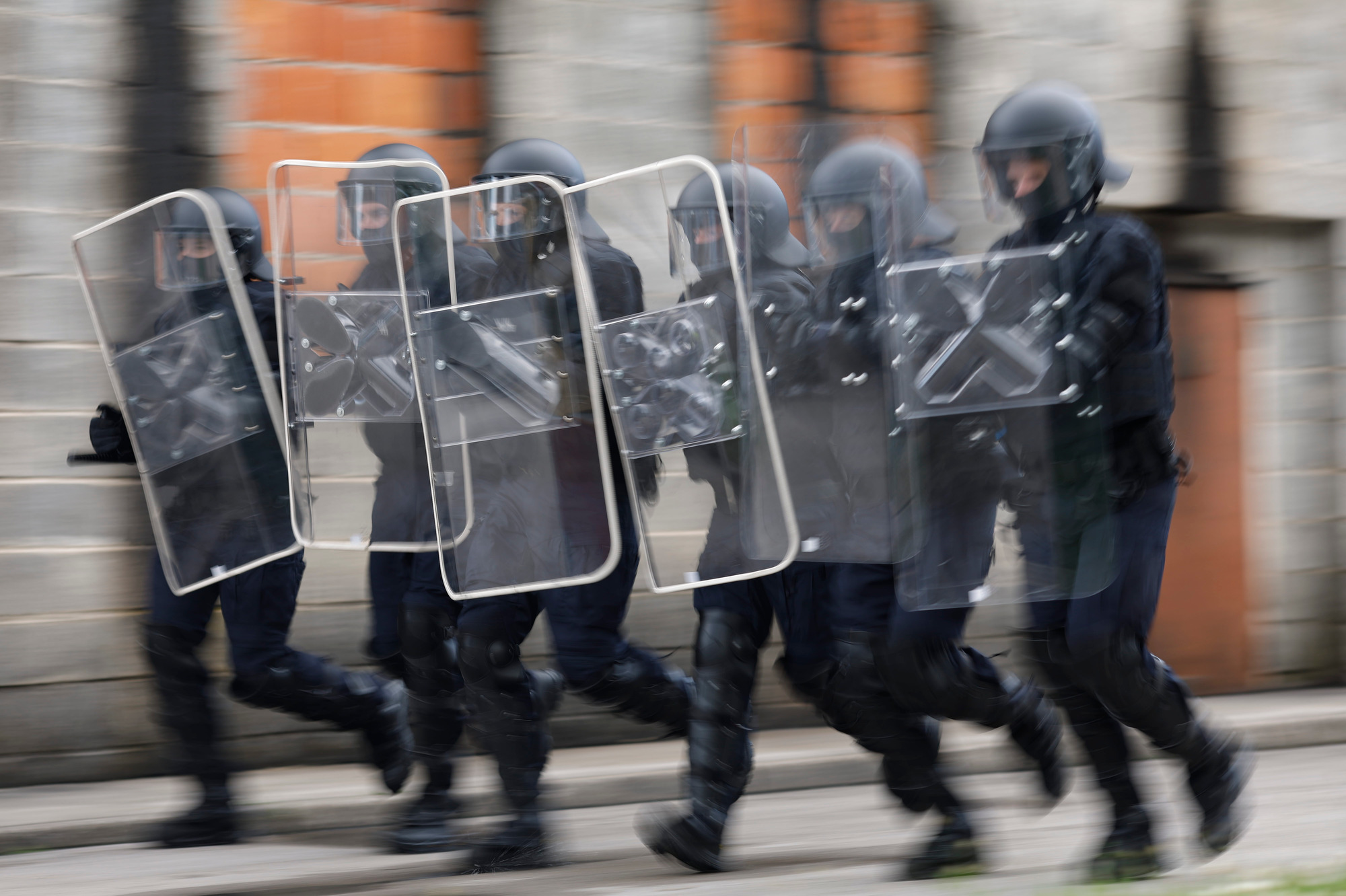
Which test regulations are decisive for the use of riot gear?
For Germany all major components of the impact protection equipment must fulfil the requirements of the TR body protection equipment of the Police Technical Institute (PTI) of the German Police University (DHPol). It describes the requirements, classifications and test procedures for stab and/or impact-resistant protective equipment such as body armour, protective helmets and protective shields, which are intended to protect body parts from injuries caused by attacks with visual and impact objects.
The most relevant protection class for riot gear is VPAM KDIW 2004 (as of 18/05/2011).
Types of potential risks for wearer
The protective systems are designed to protect the wearer from injuries caused by mechanical impact and to absorb the kinetic energy – e.g. from kicks, punches, blows with bars (e.g. metal rods), thrown or hurled stones, bottles or pieces of metal – in such a way that this does not lead to lasting physical injury to the wearer. This refers to broken bones, ligament injuries or malignant joint damage.
How should riot gear be stored and cleaned?
The need for care and maintenance of body protection systems varies depending on the material used. A distinction is made between waistcoat covers and impact protection protectors, each made from different materials by manufacturers.
Protective vest covers from Mehler Protection use 93% meta-aramid fabric. The body protectors are made of 100 % impact-resistant polypropylene.
More information on soft and hard ballistic materials can be found in our blog post.
The protective properties must be guaranteed for at least 10 years under normal service conditions. The durability of the textile carrier waistcoat and the other components is required to have a service life of at least 2 years.
The ballistic protection and any stab protection should be removed from the waistcoat for cleaning with standard detergents. For hygienic reasons, the protective package should be placed in a moisture-repellent, age-resistant cover (service life at least 10 years).
You can find out more about cleaning plate carriers in our blog post on plate carriers.
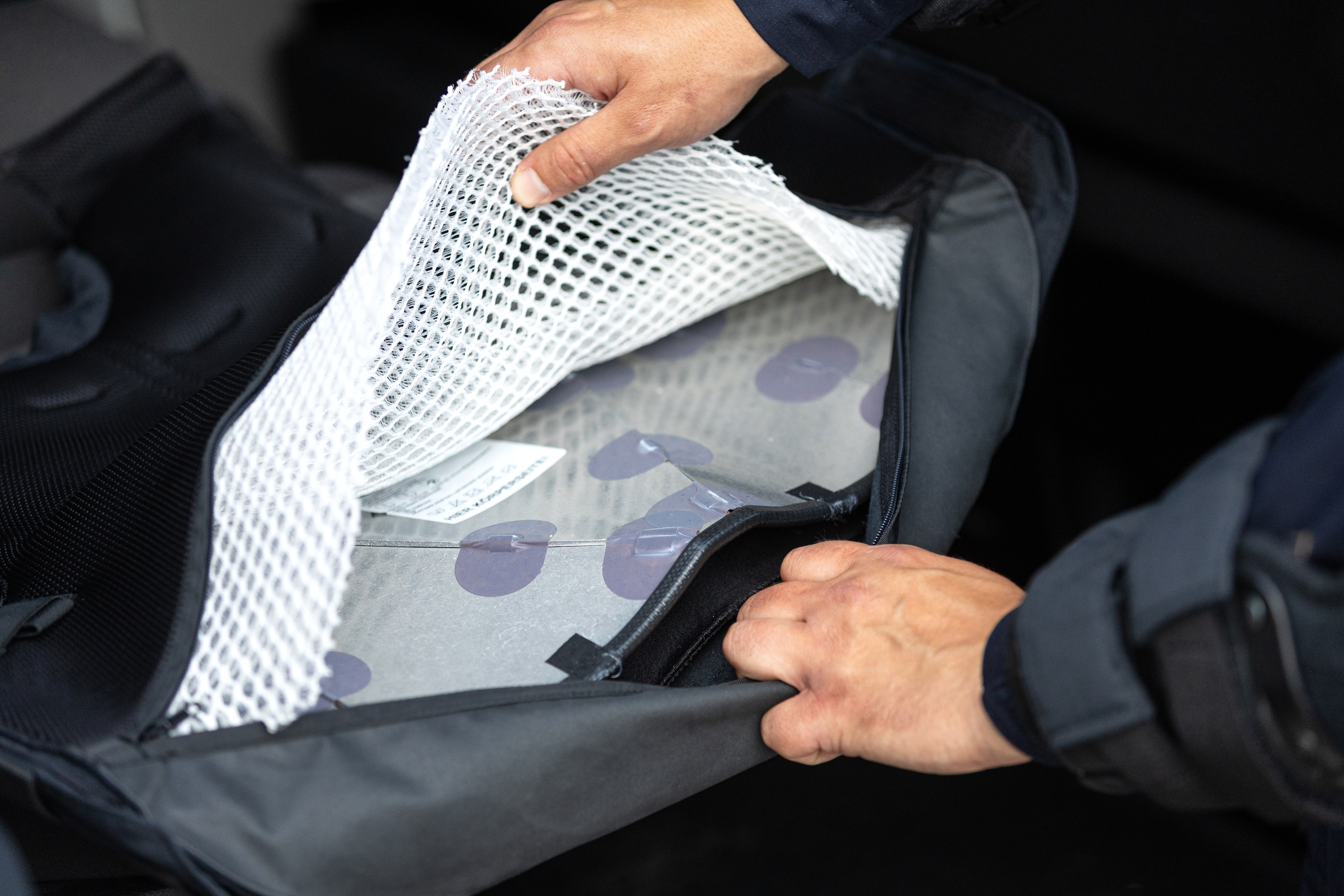
What advantages does riot gear from Mehler Protection offer?
As a leading supplier of personal protective equipment, we are committed to continuously advancing our riot control equipment for our customers in police, law enforcement agencies, and the justice sector. All our systems are certified according to current standards, offering a comprehensive protection concept, excellent mobility and comfort, a perfect fit, and additional flame-retardant properties.
Adaptable protective gear
We specialise in customised protective equipment designed to keep operators safe. Our riot gear is widely recognised for its exceptional durability and safety features. Choose from Modular, Flexible Body Protection with Slash, Impact and Stab Protection combinations.
Key advantages for Mehler Protection´s riot gear
1) High-level protection
Our products are essential for high-threat situations, providing robust protection against blunt force trauma with a comfortable, secure fit. Lightweight and easy to deploy, our riot gear offers full-body coverage through flexible moulded polypropylene panels. Available in various protection levels, our gear integrates seamlessly with soft- and hard-ballistic options for enhanced safety.
2) Freedom of movement
Riot gear enables the wearer to maintain the agility and responsiveness that is essential for effective navigation in volatile and dynamic environments. This freedom of movement allows personnel to react quickly to changing situations, enhancing their ability to manage crowd dynamics and maintain control without compromising their safety or operational effectiveness.
3) Psychological comfort
The peace of mind that comes from knowing they are well protected increases the confidence, allowing to focus more on duties without undue stress or distraction. This contributes to better decision-making and overall effectiveness in dealing with high-pressure situations, ensuring that operators can perform their duties with greater clarity and resilience.
4) Flame-retardant option
In addition to our regular riot gear, we also make a flame-retardant version. The padding, Velcro® fasteners, plastic/aluminium pieces, textiles, and other components are all certified flame-retardant.
Summary
Considering the increasing global protests and civil unrest, the importance of adequate protective equipment for police forces is becoming more and more apparent. In this blog post, we provide a detailed overview of the key components of riot gear and discuss additional features. The technical guideline ‘Body Protection Equipment’ establishes the standards for high-quality systems, ensuring that a full-body riot gear kit offers protection against injuries from stabbing and striking objects.
Ultimately, it is essential that riot gear is designed to provide optimal protection in high-risk situations for foot patrol officers, mounted police, law enforcement, and correctional authorities. Only through continuous development and adaptability can riot gear meet the evolving demands of our time.
Explore more: Riot Gear
Sources
- Frankfurter Rundschau, Jannek Ringen (28.07.2024), Sicherheit bei Olympia: Sogar deutsche Spezial-Polizisten im Einsatz – sie haben besondere Befugnisse
- Technische Richtlinie (TR) Körperschutzausstattungen, Polizeitechnisches Institut (PTI) der Deutschen Hochschule der Polizei (DHPol) (2009), Technische Richtlinie (TR) Körperschutzausstattungen
Images and graphics
Mehler Protection, Mehler Vario System GmbH (All rights reserved, 2024)
